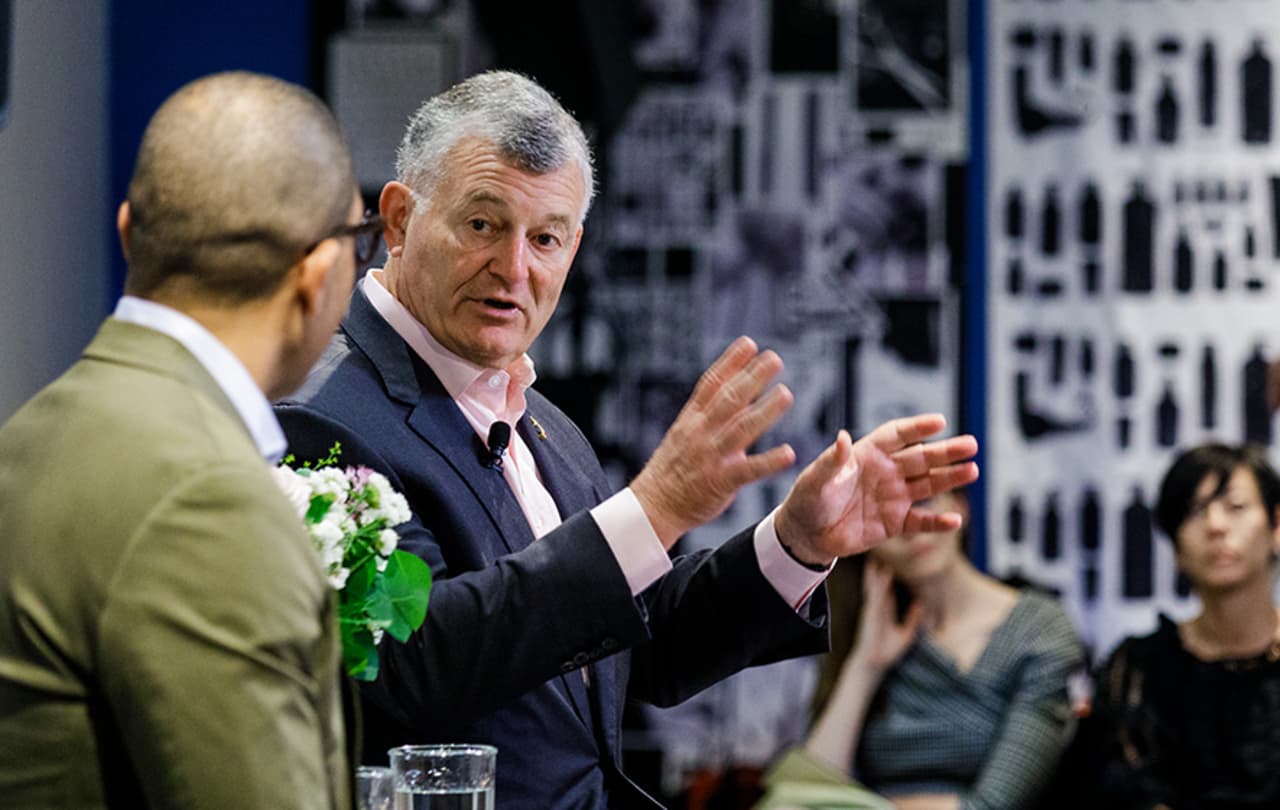Estée Lauder Executive Chairman Says Good Leaders Have ‘Big Ears and a Little Mouth’
William P. Lauder might be a familiar name. His grandmother, Estée Lauder, founded her namesake brand in 1946 and grew it into one of the largest beauty companies today. Currently, the Estée Lauder Cos. have more than 45,000 employees worldwide and own over 20 brands, including Clinique, Tom Ford Beauty, La Mer, and Jo Malone.
Lauder, 64, is now the company’s executive chairman and chairman of the board of directors. He got his start in 1986 as the regional marketing director of Clinique U.S.A. in the New York metro area, helped launch the natural ingredients brand Origins, and eventually rose all the way to serve a stint as CEO of Estée Lauder in the late aughts. (It was recently announced his successor, longtime CEO Fabrizio Freda , will retire next summer amid slumping sales.)
In addition to his current position, Lauder teaches a class that he designed, “Decision-Making in the Leadership Chair,” at the Wharton School of the University of Pennsylvania for second-year MBA students.
Penta recently spoke to Lauder about his most memorable career moments, consumer preferences in the beauty industry, and his thoughts on leadership.
Penta : What is your role at Estée Lauder?
William P. Lauder: We have two great assets: brands and people, and my primary focus is to build great brands and to engage with our people. I travel and visit a lot of our markets and see how we can grow in that market. We have a presence in London, Paris, Korea, and many other international destinations. I host a town hall for Estée Lauder Cos. employees in many of our markets and talk to them about what makes us special and what our values are.
I also visit our factories and research and development facilities to do the same thing.
Can you share a career highlight since you joined 38 years ago?
I was one of the people who created and launched the Origins brand in 1990. The idea was to create a line that was backed by science but made with natural ingredients. We had a product called Peace of Mind to put on your temples and wrists to help relieve stress. We let people sample it in stores, and they loved it so much that they immediately came back to buy it. From there, the brand exploded, and we opened Origins stores. This was innovative at the time because single-brand stores didn’t exist.
Since I’ve moved into corporate management, my highlight is to be able to travel and show the Estée Lauder Cos. flag, as I like to call it, to our employees.
Have are consumer preferences with respect to luxury fragrances and beauty products changing?
post-Covid, there has been an explosion in interest in luxury fragrances, which is reflected in our brands like Jo Malone London, Le Labo, Editions de Parfums Frédéric Malle, Tom Ford, and Kilian Paris.
Also, we have new, much younger consumers in their late teens to early 20s who are very into makeup and buy our brands like Too Faced. They are getting into skin care by buying products from our brands, including Clinique and the Ordinary. Teenage boys are very interested in fragrances and buy Kilian Paris and Tom Ford. Our hope is that this younger generation continues their loyalty to us, especially as they get older and have more disposable income.
You teach a leadership class at Wharton. In your opinion, what are the attributes of a successful leader?
First and foremost, the most effective leaders must be effective communicators. I believe in short, quick, and concise comments and statements that you repeat, like mantras. These mantras should be able to be passed down to the people they lead.
Also, you have to be a great teacher to be a great leader. You need to make time for an in-depth conversation with the people you lead to get your message across.
And it’s important to have big ears and a little mouth. Listen more and talk less.
Breast cancer research is a priority for Estée Lauder. Can you tell us more about this?
The Breast Cancer Research Foundation (BCRF) is a nonprofit that my mother, Evelyn, started more than 30 years ago. We, as a family, chose breast cancer because it’s the most common cancer that women are diagnosed with. One in eight women in the U.S. will be diagnosed with breast cancer, and 80% of our employees are women, so the statistic resonates.
The Estée Lauder Cos. Breast Cancer Campaign, our initiative that funds BCRF, is key to our company culture and a cause that brings us together meaningfully. In October, for Breast Cancer Awareness Month, we launch products across some of our brands, and proceeds from sales go toward the foundation. The campaign and the Estée Lauder Cos. Charitable Foundation have raised more than US$131 million to date for BCRF.
This interview has been edited for length and clarity.
 Copyright 2020, Dow Jones & Company, Inc. All Rights Reserved Worldwide. LEARN MORE
Copyright 2020, Dow Jones & Company, Inc. All Rights Reserved Worldwide. LEARN MORE
A divide has opened in the tech job market between those with artificial-intelligence skills and everyone else.
A 30-metre masterpiece unveiled in Monaco brings Lamborghini’s supercar drama to the high seas, powered by 7,600 horsepower and unmistakable Italian design.
A divide has opened in the tech job market between those with artificial-intelligence skills and everyone else.
There has rarely, if ever, been so much tech talent available in the job market. Yet many tech companies say good help is hard to find.
What gives?
U.S. colleges more than doubled the number of computer-science degrees awarded from 2013 to 2022, according to federal data. Then came round after round of layoffs at Google, Meta, Amazon, and others.
The Bureau of Labor Statistics predicts businesses will employ 6% fewer computer programmers in 2034 than they did last year.
All of this should, in theory, mean there is an ample supply of eager, capable engineers ready for hire.
But in their feverish pursuit of artificial-intelligence supremacy, employers say there aren’t enough people with the most in-demand skills. The few perceived as AI savants can command multimillion-dollar pay packages. On a second tier of AI savvy, workers can rake in close to $1 million a year .
Landing a job is tough for most everyone else.
Frustrated job seekers contend businesses could expand the AI talent pipeline with a little imagination. The argument is companies should accept that relatively few people have AI-specific experience because the technology is so new. They ought to focus on identifying candidates with transferable skills and let those people learn on the job.
Often, though, companies seem to hold out for dream candidates with deep backgrounds in machine learning. Many AI-related roles go unfilled for weeks or months—or get taken off job boards only to be reposted soon after.
Playing a different game
It is difficult to define what makes an AI all-star, but I’m sorry to report that it’s probably not whatever you’re doing.
Maybe you’re learning how to work more efficiently with the aid of ChatGPT and its robotic brethren. Perhaps you’re taking one of those innumerable AI certificate courses.
You might as well be playing pickup basketball at your local YMCA in hopes of being signed by the Los Angeles Lakers. The AI minds that companies truly covet are almost as rare as professional athletes.
“We’re talking about hundreds of people in the world, at the most,” says Cristóbal Valenzuela, chief executive of Runway, which makes AI image and video tools.
He describes it like this: Picture an AI model as a machine with 1,000 dials. The goal is to train the machine to detect patterns and predict outcomes. To do this, you have to feed it reams of data and know which dials to adjust—and by how much.
The universe of people with the right touch is confined to those with uncanny intuition, genius-level smarts or the foresight (possibly luck) to go into AI many years ago, before it was all the rage.
As a venture-backed startup with about 120 employees, Runway doesn’t necessarily vie with Silicon Valley giants for the AI job market’s version of LeBron James. But when I spoke with Valenzuela recently, his company was advertising base salaries of up to $440,000 for an engineering manager and $490,000 for a director of machine learning.
A job listing like one of these might attract 2,000 applicants in a week, Valenzuela says, and there is a decent chance he won’t pick any of them. A lot of people who claim to be AI literate merely produce “workslop”—generic, low-quality material. He spends a lot of time reading academic journals and browsing GitHub portfolios, and recruiting people whose work impresses him.
In addition to an uncommon skill set, companies trying to win in the hypercompetitive AI arena are scouting for commitment bordering on fanaticism .
Daniel Park is seeking three new members for his nine-person startup. He says he will wait a year or longer if that’s what it takes to fill roles with advertised base salaries of up to $500,000.
He’s looking for “prodigies” willing to work seven days a week. Much of the team lives together in a six-bedroom house in San Francisco.
If this sounds like a lonely existence, Park’s team members may be able to solve their own problem. His company, Pickle, aims to develop personalised AI companions akin to Tony Stark’s Jarvis in “Iron Man.”
Overlooked
James Strawn wasn’t an AI early adopter, and the father of two teenagers doesn’t want to sacrifice his personal life for a job. He is beginning to wonder whether there is still a place for people like him in the tech sector.
He was laid off over the summer after 25 years at Adobe , where he was a senior software quality-assurance engineer. Strawn, 55, started as a contractor and recalls his hiring as a leap of faith by the company.
He had been an artist and graphic designer. The managers who interviewed him figured he could use that background to help make Illustrator and other Adobe software more user-friendly.
Looking for work now, he doesn’t see the same willingness by companies to take a chance on someone whose résumé isn’t a perfect match to the job description. He’s had one interview since his layoff.
“I always thought my years of experience at a high-profile company would at least be enough to get me interviews where I could explain how I could contribute,” says Strawn, who is taking foundational AI courses. “It’s just not like that.”
The trouble for people starting out in AI—whether recent grads or job switchers like Strawn—is that companies see them as a dime a dozen.
“There’s this AI arms race, and the fact of the matter is entry-level people aren’t going to help you win it,” says Matt Massucci, CEO of the tech recruiting firm Hirewell. “There’s this concept of the 10x engineer—the one engineer who can do the work of 10. That’s what companies are really leaning into and paying for.”
He adds that companies can automate some low-level engineering tasks, which frees up more money to throw at high-end talent.
It’s a dynamic that creates a few handsomely paid haves and a lot more have-nots.
Ophora Tallawong has launched its final release of quality apartments priced under $700,000.
Australia’s market is on the move again, and not always where you’d expect. We’ve found the surprise suburbs where prices are climbing fastest.























